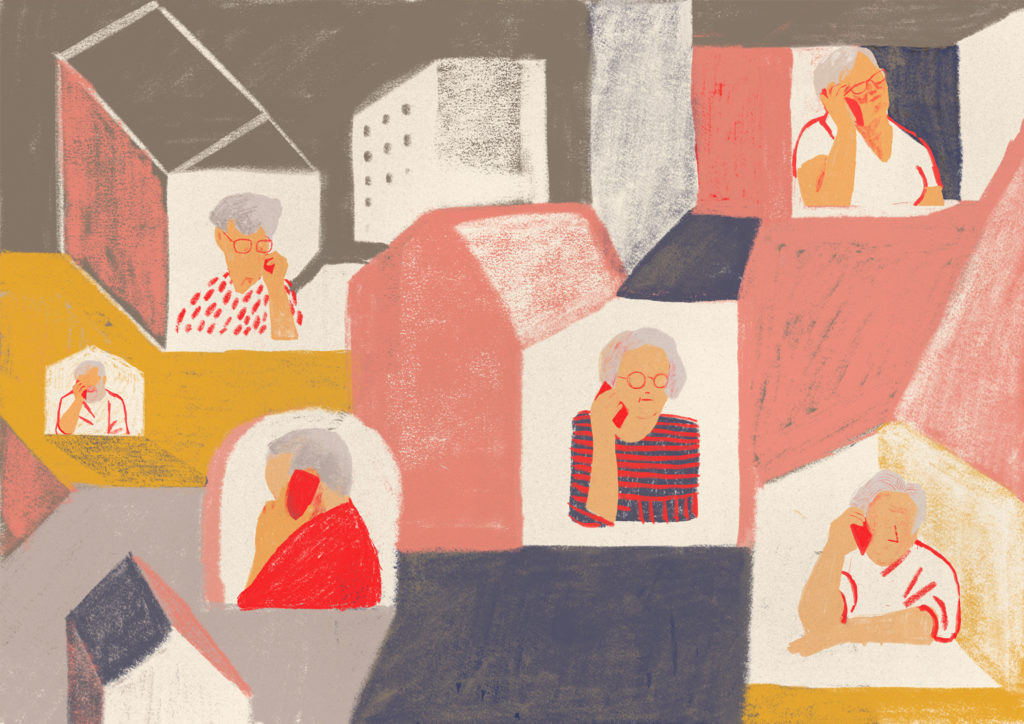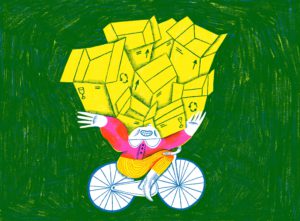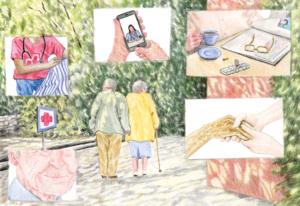
Illustrator: Xavier Pueyo
Description
Transformation of offline support groups into telephone based support and intervention groups for older persons during COVID-19 lockdown period.
Context
Persons over the age of 65 in Serbia have by government decree been prohibited from leaving their homes between early April and late May 2020 in response to the rising number of COVID-19 infections. This measure was the harshest of all epidemiological measures in the period; other age groups were also facing curfews and in some cases curfews would take two or three days, but for persons over 65 this was almost a three months uninterrupted house arrest. While contributing to their epidemiological safety, this measure introduced a number of logistical problems, especially for persons with no close relatives or neighbours, and had a significant effect on their mental health. Many older persons later testified about their overall perception of own health significantly deteriorating due to isolation and loneliness. In addition to increasing the risk of depression, for some older persons isolation meant impossibility of getting assistance in case of urgent health or social need.
Technical details & Operations
The Red Cross of Serbia has helped establish 32 self-help groups for older persons in 20 municipalities across the country in the previous years. These small informal groups are flexible in structure and operation, they consist of older persons brought together by affiliation, common interests or some other criterion, and they have regular meetings in which they engage in different activities, ranging from pastimes, through exchanging important information (regarding, for example, social welfare or healthcare services and how to access them) to local level activism (for example advocating for a less polluted local environment).
The activities of these self-help groups – based on the principles of healthy ageing – were unable to continue during the lockdown due to the impossibility of any older persons leaving their homes and meeting physically. Therefore, the Red Cross of Serbia encouraged and brokered transition of these groups into a telephone and app-based circles.
In such context, members of the telephone circles are simultaneously both beneficiaries and volunteers. Persons with higher technical expertise in using smartphones acted as primary volunteers to get others on board as well as tutors to their peers on how to use calls, text messages or dedicated communication applications such as Viber or Skype. However, every person was able to contribute through alerting other members of the group/ circle of a person they know who might benefit from being included – an older lonely neighbour or some such.
Deployment & Impact
Telephone circle is a low-tech and time/ cost efficient solution to check upon the status of older persons every day and be alerted if there is potentially a need for intervention.
In practice, the activity is implemented by connecting 10-15 older persons who are mostly living alone or in older households and may have difficulties leaving their homes. To decrease the risks of social exclusion for them and increase the likelihood that they will get timely help and support in urgent matters the telephone circles functions through following procedure:
– The lead volunteer – the older person with more experience – calls the first person in the circle every day at the same time. This conversation is kept short; it is a daily check-up call on whether this person is well.
– This confirms if they are well and then calls the next person in the circle. Again, this is a short call just to check-up on the next person.
– Upon confirming, the second person in the circle calls the next person and so on until the last person in the circle calls back to the lead volunteer and confirms that the circle has been closed and that everyone answered their phones and is well.
– The whole circle is closed in 15-20 minutes maximum and this repeats every day.
In cases where a person in the circle cannot be reached upon repeated calls, the caller directly contacts the lead volunteer to alert that the circle cannot be continued and then the lead volunteer can get in touch with the local Red Cross of Serbia branch to ensure someone physically checks up on the person breaking the circle and provides them with urgent assistance if needed.
The transformation of self-help groups into telephone circles was a natural way of ensuring both that more active older persons with a history of volunteering for the Red Cross could continue to be active despite the lockdown, as well as that older persons in need of support were not socially excluded and isolated. The effects on mental health of both these groups were beneficial, making sure that older persons would both feel that they are not abandoned and are participating in the society, that they can get support through their peers if needed, and that they can equally contribute to their peers. This challenges loneliness and develops a sense of security in older persons who benefit psychologically both from knowing they are taking care of someone but that someone is there for them at all times.
The telephone circles also spontaneously evolved into groups with more telephone based activity with older persons communicating several times per day on different topics, providing information on other older persons in potential need for assistance and support and informing the Red Cross branches of their existence, location and contact details.





